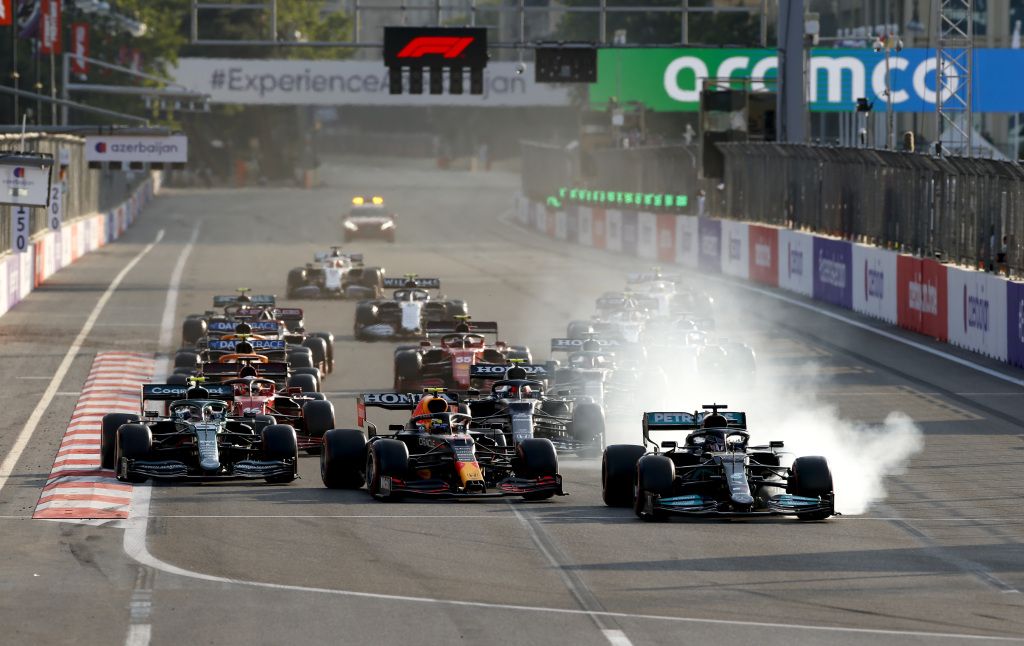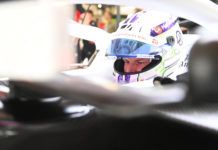Mercedes technology director Mark Elliott dwells into the troubles faced by both Lewis Hamilton and Valtteri Bottas in F1 Azerbaijan GP.
It was not a smooth sailing for Mercedes eventually in F1 Azerbaijan GP, where it was much worse than Monaco, with the German manufacturer failing to score any points and Red Bull managed to extend its advantage in the constructors’ championship.
In their usual post-race debrief, Mercedes had its technology director, Eliott, this time around to elaborate on the troubles faced by both Hamiilton and Bottas in Baku. He talks about the different wings setting on the cars and also qualifying plans.
Further, Elliott goes deep about the troubles faced by Hamilton on the re-start, with the brake button, while also discussed why Bottas fared so bad all-weekend long. Here’s what the Mercedes man said in a list-like format:
Different wing set-ups – higher for Bottas and lower for Hamilton:
Mercedes: “Well, actually the setups were fairly similar, probably the biggest difference between the two cars was the wings that they were running. So, Lewis ran a lower downforce level, the level that the simulations predicted would be optimum. And Valtteri chose a slightly higher downforce level, something we predicted would be a little bit slower, maybe a tenth of a second a lap slower.
“So, how do we go about choosing that and why did we end up in that position? Well, that was Valtteri’s choice to run that wing and he did that because he felt that would be quicker for him. What you need to understand is, this is a difficult circuit. It’s a circuit where it is quite hard to get heat into the front tyres and it’s one where you need real confidence to get around this circuit because the walls are really close.
“Getting heat into these tyres is really important and if you can go a little bit quicker, put a little bit more energy into those tyres the car will go quicker as a result and you end up in a positive performance spiral. So, it’s more important that Valtteri was happy with his car, that he felt confident in his car, than the small difference the simulation predicted in ultimate performance.”
Qualifying tow and the general plan:
Mercedes: “We have a set of rules that we apply to make it fair for the drivers race to race and one of those rules is that race by race, each driver gets to decide whether they go first or second in qualifying. So, this weekend it was Lewis’s turn and Lewis decided because of the benefit of the tow that he would go second. Now, normally that wouldn’t matter too much because normally what we try to do is to get Valtteri in a good position on the track so that he can get a tow from his competitors, from the other cars.
“One of the difficulties we faced this weekend is we were trying to use a prep lap to get the best lap, that’s how we felt to get the quickest time. So, what we do is we go out the pits, we go round the start/finish straight, we go round again and then start our fast lap. And that’s just about trying to get the tyres into the right window. Unfortunately for Valtteri and for us, our competitors weren’t doing the same, they were trying to get their fastest lap on their first lap after their out lap and that made it really difficult to try and get Valtteri in the right place relative to competitors so that he would get a good tow.
“If you look at what happened to Leclerc as well, we had a similar problem there where we towed Leclerc up the start/finish straight, giving him an advantage in his own qualifying and that was from exactly the same problem. It was difficult to position ourselves relative to the competitors. And on the very last run in qualifying, actually Valtteri did end up in a good position for a tow, he was also on a really quick lap, probably not quick enough to be pole but quick enough to be a lot further up the time sheets but unfortunately the red flag put pay to that.”
Hamilton’s damage to front wing under red flag:
Mercedes: “The reality is, we don’t actually really know. Lewis picked up that damage as a result of going through the debris that came from Max’s crash. And actually, we ended up with a chunk of debris stuck between the rear suspension and the diffusor and that was probably the biggest impact aerodynamically. So, trying to separate out the front wing was too difficult, but what did happen was the red flag obviously gave us an opportunity to fix both problems, in some ways we were lucky with that.”
Smokes from Hamilton’s brakes upon re-start:
Mercedes: “The drivers are trying to get the tyres in the optimal window for the start, they are trying to do lots of other things on that lap to the grid, but in trying to get the tyres to the optimal state what they need to do is to put heat into them. On the rears, it is relatively easy, the drivers spin the wheels up and therefore they put surface temperature in that way. On the fronts, the driver will weave, or he will put heat in it from the brakes.
“So, Lewis was trying to maximise the heat he was pushing into the rim from the brakes and that caused them to get hot enough that they smoked. It is not an issue at all because as soon as the car gets going and the air flow starts coming through the brake ducts the brakes will then cool down again and that’s completely fine. And so that wasn’t the issues that Lewis then had at the first corner, it is completely something different.”
Brake button and all post re-start:
Mercedes: “At the start, at the beginning of the race we are not actually allowed to talk to the drivers. So, we can’t talk them through the settings they need to change. So, as a result of that we try and simplify things as much as we possibly can. We try to produce tools the drivers can use, that reduces the workload they have to go through because there is a huge amount for them to do. So, one of the buttons we’ve got, it’s called ‘brake magic’, to be honest, I don’t know why we call it ‘brake magic’, is a button that the drivers can press and that allows them to get heat into the brakes.
“One of the big things it does is it moves the brake balance, so the proportion of the front brake energy to the rear brake energy all the way as far forward as we can get it and that allows us to put heat into the front brakes and therefore heat into the rims and into the tyres. So, Lewis had done all the right things, he got the car to the grid, he switched off the various buttons and settings he needed to switch off, switched on the ones he needed to switch on, it was all set to start the race properly.
“He made a fantastic start, he got himself up alongside Perez and as he and Perez were sort of shuffling position Lewis swerved and in the process of swerving he just clipped the magic button and unfortunately he didn’t feel he had done it. So, he had completely no awareness he was going to have a problem. The point he then braked, which was the normal point for him to brake, he was in the position where he got all of the brake balance shifted forward, which put all of the load through the front tyres and as a consequence they locked and from that point there was nothing that he could do than go wide.
“I know speaking to Lewis yesterday that Lewis sort of feels a chunk of blame for that, but the reality is Lewis makes so few mistakes and that’s what really sets him apart from some of the other drivers. It’s our duty to try and give him a car where it’s more difficult for him to make mistakes. We need to take our share of that, look at how we can improve that and that’s something we will put in place for the next race.”
Bottas’ struggles all-weekend along:
Mercedes: “I think at this circuit one of the difficulties is getting the warm-up of the front tyre and it is also a circuit where you need to have real confidence, the walls are really close and if you get it wrong you are going to put it into the wall. Those two things kind of go together because if you can go a little bit quicker, if you can get yourself a little bit closer to the wall because you are confident, then you get a bit more heat into the tyres because you have got more duty.
“If you get more heat into the tyres you get a bit more grip and you can go faster and so you end up with this sort of positive spiral that I mentioned before. If I look at the weekend I think Lewis found a little step in FP3 with setup and that seemed to help him find a little bit more from the car and all of a sudden we went from struggling a bit to being really in the front runners on the pace and Lewis took that all the way through qualifying. The lap he set in Q3 to be second, it wasn’t one lap he was actually quick all through qualifying.
“With Valtteri, I think Valtteri just didn’t get to that position. He didn’t find that, sort of, last little bit of confidence to be in that positive spiral in the same way and I think if you look at the weekend as a whole and you look at what happened in qualifying and you look at what happened in practice there were a lot of drivers who understeered wide and put the car into the wall, presumably because they didn’t get the front tyres into the window, and to the credit of our drivers both of our drivers avoided that mistake.
“I think it is also worth bearing in mind that if you sort of look at this weekend and compare it to last weekend in Monaco, in Monaco it was Valtteri who was able to get the tyres into the window and get the best of them and it was Lewis that was struggling a bit more. So I think this is something that we need to understand as a team, it is something we need to work on and improve because if we don’t improve on that there will be other circuits this year where we will find the same problems.”
Here’s Valtteri Bottas on weird Baku race
Here’s Lewis Hamilton on button plus Toto Wolff adds on



















